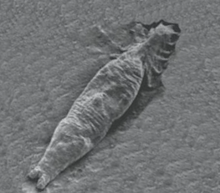Gyrodactylus salaris
| Gyrodactylus salaris | ||||||||||||
|---|---|---|---|---|---|---|---|---|---|---|---|---|
| Systematics | ||||||||||||
|
||||||||||||
| Scientific name | ||||||||||||
| Gyrodactylus salaris | ||||||||||||
| Malmberg , 1957 |
Gyrodactylus salaris is a flatworm species of the genus Gyrodactylus from the class of hooked suckers ( Monogenea ). It is a small ectoparasite (about half a millimeter long)that livesmainly on the skin of freshwater fish, especially the Atlantic salmon . Other species that it parasitizes are the rainbow trout , the arctic char , the brook trout , the European grayling , the American arctic char and the brown trout .
Way of life
The parasite attaches itself to the fish with the help of a large rear attachment device , the so-called haptor , on which there are sixteen sharp hooks. The parasite is not visible to the naked eye, only with a magnifying glass. The parasite places its head end towards the fish to eat. It everts its pharynx out of its mouth and releases a digestive solution that contains a proteolytic enzyme that dissolves the fish skin. Mucus and loosened skin are then sucked into the intestines. Infestation by many of these parasites can result in large wounds and extensive damage to the host fish's epidermis . This eases secondary infections from other pathogens and makes the fish more susceptible to further diseases. The parasites give birth to live young that are almost as big as they are, and at this point another generation is growing in the newborn.
Combat
Catastrophic losses of Atlantic salmon occurred in Norway in the 1970s after the introduction of G. salaris . By 2001, the salmon populations of 41 Norwegian rivers were practically wiped out in this way.
The parasite cannot survive in seawater because of the high salt content, so that the infection of a fish population does not lead to their further spread through the migration of the fish. Historically, Gyrodactylus infected rivers have been treated with the indiscriminate use of the pesticide Rotenone , killing not only the parasite, but also the fish, requiring resettlement. A newer method uses a low dosage of aqueous aluminum and sulfuric acid . A great advantage of this method is its ability to kill the parasites without harming the hosts. This new method has shown promising results in the two Norwegian rivers Batnfjordelva and Lærdalselva .
On August 17, 2012, the world's largest Rotenone campaign at the time began in Norway, in the course of which 340,000 liters of Rotenone are to be introduced into the Vefsna river system.
The parasite was removed from 22 rivers from the formerly 49 infected rivers, 18 more rivers have been treated and have been under observation since then, 2 rivers are currently under treatment, the eradication work has started in 4 infected rivers and nothing has been done in 3 infected rivers (As of June 23, 2016).
Individual evidence
- ↑ a b c d Gyrodactylus salaris , Scotland.gov, accessed November 11, 2010.
- ↑ Do not spread salmon parasite Gyrodactylus salaris . Finnish Ministry of Agriculture and Forestry. Archived from the original on August 30, 2005. Retrieved November 11, 2010.
- ↑ Gyrodactylus salaris (PDF; 174 kB) DAISIE - europe-aliens.org. Retrieved November 11, 2010.
- ↑ http://www.regjeringen.no/nn/dep/md/pressesenter/pressemeldinger/2011/gyro-behandling-av-laksevassdrag-i-vefsn.html?id=643017
- ↑ Gyrokampen i Norge. In: www.drivaregionen.no. Retrieved September 8, 2016 .

